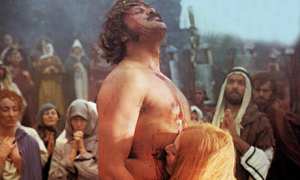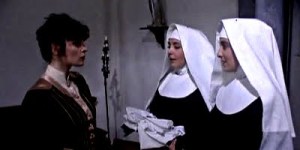THIS POST IS RECOMMENDED FOR MATURE AUDIENCES
 When Ken Russell unleashed his shocking The Devils on an unsuspecting world in 1971, it produced a bizarre side-effect: the nunsploitation genre. Spain and Italy, where Catholicism holds the greatest sway, were the breeding grounds for these bizarre efforts whose makers reckoned that audiences couldn’t get enough of sexually frustrated nuns, tortured nuns, demonically possessed nuns and—most importantly—naked nuns.
When Ken Russell unleashed his shocking The Devils on an unsuspecting world in 1971, it produced a bizarre side-effect: the nunsploitation genre. Spain and Italy, where Catholicism holds the greatest sway, were the breeding grounds for these bizarre efforts whose makers reckoned that audiences couldn’t get enough of sexually frustrated nuns, tortured nuns, demonically possessed nuns and—most importantly—naked nuns.
Though many of these films are hilarious and mind-boggling to watch now, it makes one wonder who the original target audience was and how they received them. My guess would be kinky Catholic guys who were abused by nuns as schoolboys and enjoyed watching the films as a kind of vicarious revenge therapy. There were two kinds of nunsploitation films: those featuring nuns battling against corrupt, hypocritical superiors; and those featuring actual demonic possession. Sometimes the two strands merged.
 Prolific (and opportunistic) director Jesse Franco was one of the first off the block with the oddly-titled Love Letters of a Portuguese Nun in 1973, though it wasn’t released until years later due to censorship problems. It’s about a girl who is sent to a convent after being caught trysting with her boyfriend. To her horror, she discovers that the priest who supervises the place and the nuns who live there are actually satanists.
Prolific (and opportunistic) director Jesse Franco was one of the first off the block with the oddly-titled Love Letters of a Portuguese Nun in 1973, though it wasn’t released until years later due to censorship problems. It’s about a girl who is sent to a convent after being caught trysting with her boyfriend. To her horror, she discovers that the priest who supervises the place and the nuns who live there are actually satanists.
Of course, there are plenty of elements here that would come to typify the genre—lesbian sex, torture and a special guest appearance by the Dark One himself. Fans say this is one of Franco’s best, which depends entirely upon one’s tolerance for smash zooms and incoherence.
In preparation for writing this post, last night I watched Flavia the Heretic (1974), an Italian-French coproduction directed by Gianfranco Mingozzi, a documentary filmmaker who nevertheless displays some good dramatic chops here. It’s about a young woman whose father forces her to become a nun and she enters a convent run by a nasty bishop and a Mother Superior who seems to have eyes only for Flavia.
She’s an early feminist, though. Furious at being forced to live in a male-dominated society, and she repeatedly escapes the convent, only to be captured and brought back. Finally she joins an army of Muslims and enlists their help in storming the convent and exacting her revenge on those who’d wronged her. At one point, she appears on horseback in full battle armor, looking just like Joan of Arc.
 Florinda Bolkan plays Flavia, a familiar face from Lucio Fulci’s (also religious-themed) 1972 Don’t Torture the Duckling. And the Muslim chief Flavia becomes romantically involved with is played by Anthony Corlan (Higgins), who had earlier appeared in Hammer’s superb Vampire Circus (also 1972).
Florinda Bolkan plays Flavia, a familiar face from Lucio Fulci’s (also religious-themed) 1972 Don’t Torture the Duckling. And the Muslim chief Flavia becomes romantically involved with is played by Anthony Corlan (Higgins), who had earlier appeared in Hammer’s superb Vampire Circus (also 1972).
This is far more arty than other films in the nunsploitation genre, but when it gets into the exploitation, it does so wholeheartedly. Hot oil is poured on tender flesh, there’s both female and male rape, nipples are sliced off and a horse is castrated. Mingozzi demonstrates a taste for surrealism, too, especially in a sequence in which paintings come to life, a naked woman crawls into the carcass of a butchered cow and other nude nuns frolic with equally undressed Muslim soldiers.
Japan piped up in 1974 for a rare entry into the genre, School of the Holy Beast, in which a young woman enters a convent to uncover the mysterious death of her mother there 18 years before. Her rebellious spirit doesn’t sit well with the nuns there, so the requisite beatings and mayhem ensue. School can be considered part of that country’s “pink” film industry, softcore theatrical releases that were in vogue from the 1960s until the 1980s, when home VCRs gave the general public access to hard-core pornography. Pink films were characterized by their high level of (nonexplicit) sex and violence.
Mexican filmmaker Juan López Moctezuma chimed in with 1975’s Alucarda, which sounds like a feminized anagram of Dracula but is actually the name of a young girl who enters a convent (oh, yeah—that one again) inhabited by a bizarre sect of nuns who dress like mummies. She becomes possessed by a demonic spirit and all hell breaks loose. What follows are the requisite orgies, tortures and demonic hijinks required by the genre. I haven’t seen this one, but I understand it has surrealistic, arty touches as well. (I’m going to avoid a Moctezuma’s Revenge joke here. Well, I guess I didn’t.)
Bruno Mattei, a colleague  of Franco’s (in spirit, anyhow), was another opportunistic filmmaker who didn’t hesitate to pattern his rip-offs on the latest craze. Tinto Brass’s pornographic Caligula (1979) inspired Mattei to make two sex films about the crazed emperor of his own. And Fulci’s successful Zombie (1979) provoked him to make his own gut-munching epics—even merging them with hardcore sex!
of Franco’s (in spirit, anyhow), was another opportunistic filmmaker who didn’t hesitate to pattern his rip-offs on the latest craze. Tinto Brass’s pornographic Caligula (1979) inspired Mattei to make two sex films about the crazed emperor of his own. And Fulci’s successful Zombie (1979) provoked him to make his own gut-munching epics—even merging them with hardcore sex!
He made a rather late arrival in the nunsploitation genre with The True Story of the Nun of Monza in 1980, in which—wait for it—a girl’s father forces her to enter a convent to protect her from the evils of the outside world. Too bad the outside world has already penetrated the walls of the “holy” place, as the nuns carry on with each other and even sneak out to have sex with men.
 Joe D’Amato, one of Italy’s most notorious flesh merchants, jumped into the genre with 1979’s Images in a Convent, which mixes the typical nunsploitation hijinks with brief instances of hardcore sex. He returned to the genre in 1986 with Convent of Sinners, giving whatever was left of the fan base more of what they craved. Oh, and are you ready for the plot? A girl is raped by her father and sent to a convent to atone for her sins…
Joe D’Amato, one of Italy’s most notorious flesh merchants, jumped into the genre with 1979’s Images in a Convent, which mixes the typical nunsploitation hijinks with brief instances of hardcore sex. He returned to the genre in 1986 with Convent of Sinners, giving whatever was left of the fan base more of what they craved. Oh, and are you ready for the plot? A girl is raped by her father and sent to a convent to atone for her sins…
One of the more bizarre entries here is 1978’s Killer Nun (Suor Omicidi), starring former ’50s hottie Anita Ekberg as a morphine-addicted nun who smokes, drinks, picks up men on the street for back-alley quickies and may be responsible for a series of deaths at the hospital in which she works. Sadly, despite the storyline and appearances by Warhol star Joe Dallesandro and Suspiria‘s Alida Valli, it never really catches fire. Although it has some nunsploitation elements—including the requisite lesbian scene—the violence is tame (unless you count an unprovoked assault on an old lady’s dentures) and it’s more like a mystery.
The time of the nunsploitation genre is long gone, along with the nudie cutie, the roughie and the prison camp picture. Fortunately, distributors like Something Weird, Mondo Macabro and Synapse Films thoughtfully provide contemporary audiences with DVDs so that they can experience for themselves these bizarre phases in cinematic sexuality.
